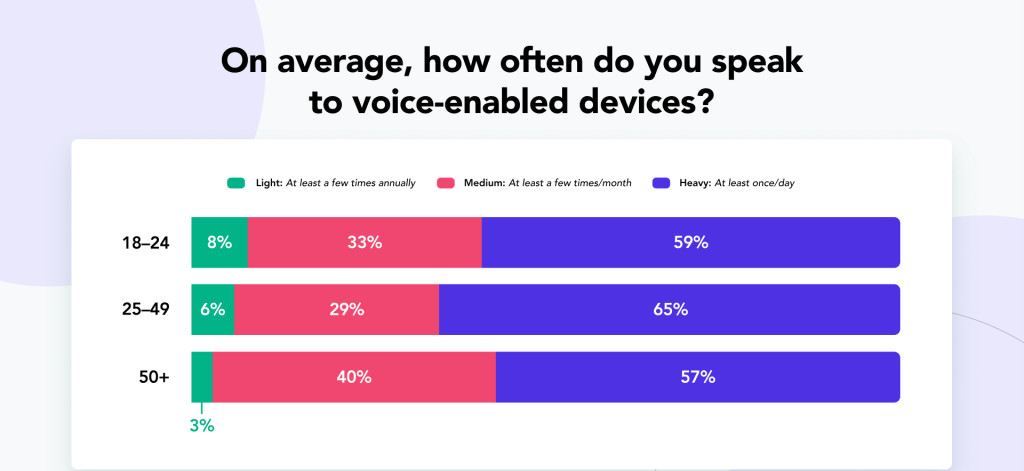In the era of smart speakers and voice-activated assistants, the way consumers search for information is undergoing a significant transformation. Gone are the days when typing a query into a search bar was the norm. Today, most of the people are simply asking their devices out loud.
This movement towards voice search is not just a passing trend—it’s reshaping the digital marketing landscape in profound ways.

The Growing Popularity of Voice Search
The digital landscape has witnessed a significant movement with the rise of voice search, and the numbers from 2023 further emphasize its growing dominance. Over a million voice searches are conducted monthly and more than 50% of adults use voice search daily. Those figures showcase the scale at which users are obtaining this technology. This massive number is not just about convenience; it’s a testament to the trust users place in voice search to provide accurate and relevant information.
One of the driving forces behind the success of voice search is the perfection with which it delivers results. An impressive 45% of voice search responses come directly from featured snippets. These snippets, often referred to as “position zero” in search results, provide concise answers to user inquiries. Their prominence in voice search results shows that search engines view them as highly relevant and trustworthy sources of information.
The integration of voice search with smart devices has played a crucial role in its widespread adoption. Smart speakers, with their seamless integration and hands-free operation into daily routines, have become a primary device for voice searches. The convenience they offer, merged with the accuracy of search results, makes them an indispensable tool for many users.
As voice search continues its upward trajectory, it’s clear that it’s not just a fleeting trend but a fundamental movement in the way users seeks information. Marketers and brands need to recognize this evolution and adapt their strategies to ensure they remain visible and relevant in this voice-driven digital era.

How Voice Search is Different
Voice searches are inherently separate from typed queries in several fundamental ways:
Conversational Tone: Voice searches tend to be more natural and conversational. Users are more likely to phrase their queries as full sentences or questions, such as “Where’s the nearest Indian restaurant?” instead of simply typing “Indian restaurant near me.”
Length of Queries: Voice search inquires is generally longer than their text-based counterparts. This is because speaking is often simpler than typing, and users are more likely to provide detailed queries when speaking.
Contextual Understanding: Voice search platforms, especially those integrated with smart assistants like Alexa, Siri, or Google Assistant, are designed to understand context. For instance, if a user asks about the weather and then follows up with “How about today?” the assistant recognizes the reference to the weather in the subsequent query.
Immediate Needs: Voice searches are frequently driven by immediate needs or on-the-go situations. A user might ask their phone where the nearest gas station is while driving or request a recipe while in the kitchen.
Integration with Other Technologies: Voice search frequently works in tandem with other technologies. For example, asking a smart speaker to play a specific song will integrate with a music streaming service, or asking about a movie might pull up show times at a local theater.
Privacy Concerns: As voice search often requires devices to be always listening for a wake word (like “Okay Google” or “Hey Siri”), there are inherent privacy concerns. Users are becoming more conscious of when and where they use voice search, mainly with devices that are always connected.
Multimodal Interactions: Some voice search platforms, especially on smart phones, offer multimodal interactions. This means that a voice query can result in a visual response on the screen, combining both visual and voice elements for a comprehensive user experience.
Dependency on Accurate Voice Recognition: The effectiveness of voice search heavily depends on the accuracy of voice recognition technology. Dialects, accents, and background noises can sometimes pose challenges, making it crucial for platforms to continually improve their voice recognition capabilities.
In essence, while text-based searches are driven by short phrases and keywords, voice searches are more about context, intent, and natural language. This shift not only effects how users search but also how businesses and marketers need to approach search engine optimization and content creation.
The Impact on SEO
The rise of voice search has brought about a paradigm movement in the world of Search Engine Optimization (SEO). Here’s how:
Conversational Content: With voice searches being more conversational, content needs to be written in a more conversational, natural tone. This means that content should answer queries directly and in a manner that sounds human.
Long-Tail Keywords: As voice search queries are usually longer, there’s a growing importance for long-tail keywords. These are more specific and longer keyword phrases that visitors are more likely to use.
Question-Based Queries: Since there are so many voice searches are phrased as questions, optimizing for these question-based queries becomes essential. This includes having FAQ sections or creating content that directly answers common queries in your industry.
Local SEO: Voice searches often have a local intent, such as “Where’s the nearest Tea shop?”. Makes sure that business listings are optimizing and accurate for local keywords is more crucial than ever.
Featured Snippets: Voice search frequently pulls answers directly from featured snippets. These are the boxes you see at the top of Google search results that directly answer a question. Securing this “position zero” can significantly increase visibility for the voice searches.
Opportunities for Brands
Voice search is not just a new way to search; it’s a golden opportunity for brands to redefine their relationship with consumers.
Building Trust: Brands that consistently provide accurate and quick answers to voice queries can establish themselves as authoritative sources, building trust among users.
Personalized User Experience: Voice search can be united with other technologies to offer personalized experiences. For instance, a user asking about a product could be provided with recommendations based on their accquire history.
E-Commerce Integration: The integration of voice search with e-commerce platforms offers a seamless shopping experience. Users can potentially order products with simple voice commands, making the purchasing process more intuitive.
Branding Opportunities: The voice assistants can be customized to have a specific accent, tone, or even personality that aligns with a brand’s identity, offering unique branding opportunities.
Challenges Ahead
While the opportunities are huge, the road ahead is not without its challenges:
Reduced Screen Time: One of the significant challenges is the potential depletion in website visits. Since voice search provides straight answers, users might not feel the need to click through to a website.
Accuracy of Voice Recognition: Different accents, dialects, and languages can pose challenges for voice recognition technology. Ensuring consistent accuracy across the board is crucial.
Privacy Concerns: Always-listening devices raise privacy concerns among users. Tech and brands companies need to address these concerns transparently.
Monetization: Traditional ads don’t fit well in a voice-search world. Marketers and brands need to innovate new ways to monetize voice search without disrupting the user experience.
Complex Queries: While voice search is excellent for straightforward questions, it might struggle with more complex ones. Makes sure that voice search can handle a broad range of queries is essential.

Conclusion
The rise of voice search is undeniable, and its effect on digital marketing is profound. Brands that recognize this shift and adapt their plans accordingly will be better positioned to thrive in this new voice-search era. As technology continues to evolve, marketers must stay ahead of the curve and embrace the opportunities that voice search presents, while also navigating the challenges it brings.

